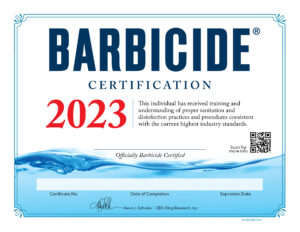As we move into year two of the COVID 19 pandemic, there has been so much change that it often seems that “normal” may never return. That said, we see signs of a return to normalcy increasing almost daily – many of us are dining indoors, attending family gatherings and providing services to the community, something that seemed impossible a year ago. In the spring of 2020 when most states went into lock down, professional beauty came to a screeching halt and there was very little information available about when services may be allowed to safely resume. When states finally started to look at reopening of businesses, often professional beauty was overlooked entirely or guidelines were provided that didn’t actually fit the salon environment. When salons were finally allowed to open, it was often with new guidelines in place that were in addition to any existing rules. These guidelines put things into place like requiring appointments, limiting people in the salon and PPE requirements. Now as the pandemic feels as though it is under control, many states are making sweeping changes to their existing orders around things like face coverings and occupancy allowances. With all of these changes, it may feel impossible to know what you are supposed to be doing!
First, virtually all of the re-opening guidelines were just that…guidelines! There does not appear to be any movement by states to make these guidelines permanent, although some of them may be desirable to keep intact. For example, if you invested in contactless payment systems or hands-free soap dispensers, these have likely streamlined daily activities and are something you will keep in place. On the other hand, if you had to move half of your chairs into storage or put plexiglass partitions in place, you may be ready to have more chairs and fewer barriers. So the question becomes, how do you know when the “guidelines” are gone? In most cases, you won’t! There likely won’t be an announcement made that you may make a choice about how many chairs you have, or if you can accept walk-ins again. While some municipalities may be more specific on what is required, it will likely revolve around issues like face coverings that affect every business in the community, not something specific to salons. Most likely, however, we will see these guidelines fade away like the empty middle seat on a plane. That said, it is worth a review of your state boards website and your local jurisdictions requirements before you bring in those extra chairs and remove the plexiglass!
Second, many of the guidelines were unclear and difficult to follow – this is your opportunity to decide how you want your business to handle considerations like PPE and other COVID initiatives when the guidelines are gone. Is it important to you and your clients that facial coverings continue to be worn even if not required in your community? If the answer is yes, then continue to require them for as long as it takes for you and your clients to feel comfortable. Maybe the answer is that you have certain clients who are more comfortable with a face covering, but the others would prefer no face covering. You could offer certain hours of the day where you will wear a face covering and require it of everyone so that your concerned clients have an alternative choice for their appointments. On the other hand if face coverings are still required in your location, you do not have the choice to allow people to enter without a face covering. Do you prefer to offer walk in’s as you did pre-pandemic instead of scheduling appointments and making people wait in their cars? As long as there are no local restrictions on occupancy, you can return to that business model although you may lose some clients who liked to be scheduled. You could continue to schedule those customers who feel strongly about it and let the rest walk in when it works for them. The thing is that all of these guidelines and directives made us think of other ways to do things than we had in the past and while some changes were difficult and costly, others proved to be worthy of becoming long term business practices. For example, scheduling appointments meant you could take time away from the salon for an appointment or lunch and not worry about missing a walk in. It also meant you could budget more accurately for your week or month, knowing how many clients you had scheduled. When the guidelines are gone, it will be your decision to keep what works and get rid of the rest!
Finally, in an industry that was so hard hit by lockdowns and fear, it is important that you work safely so that you minimize any risk of further work disruptions. Remember that every state has infection control (sanitation) rules in place and those have not changed. The guidelines about PPE, barriers, contactless systems and all of the other COVID precautions may fade away, but the rules will not. While we may all feel like COVID is in our rear view mirror, all of the pathogens of risk pre-COVID still remain a risk in the salon. For your safety and the safety of all of your clients, ensure that you know the rules of your state and follow them without fail.

